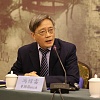On December 4, 2018, in cooperation with DGAP RIAC held a roundtable “Connecting Eurasia: EU — Russia — China — Central Asia Strategic dialogue on connectivity.” RIAC Website Editor Maria Smekalova discussed the meaning of connectivity and the ongoing projects with Fabienne Bossuyt, Assistant Professor at Ghent University, and Feng Shaolei, Director of Centre for Russian Studies, East China Normal University.
On December 4, 2018, in cooperation with DGAP RIAC held a roundtable “Connecting Eurasia: EU — Russia — China — Central Asia Strategic dialogue on connectivity.” RIAC Website Editor Maria Smekalova discussed the meaning of connectivity and the ongoing projects with Fabienne Bossuyt, Assistant Professor at Ghent University, and Feng Shaolei, Director of Centre for Russian Studies, East China Normal University.
Connectivity has become a somewhat trendy topic recently. There are a lot of talks on the matter, but no clear understanding seems to be present. What does it mean to you?
Fabienne Bossuyt: For me, connectivity is seen in terms of how countries and cities can better connect through transport in order to improve the trade between the regions. I focus mainly on the EU and Central Asia, Belt and Road Initiative and how it can link up with European continent. Central Asia is a region that is basically landlocked. They are suffering from their geographical location in terms of their trade with the rest of the world. By increasing connectivity, this region will definitely benefit economically.
The very topic of connectivity became somewhat trendy since China came out with its Belt and Road Initiative, initially called One Belt — One Road, in 2013. Some of this was new. But a lot of things that China is doing under this Initiative were happening before. The new part is the enormous amounts of money China is planning to spend to support this Initiative. Other countries that are involved in the Initiative have started to take the whole thing very seriously. It took a while for the EU to come up with a good strategic response. It is clear that China is very serious about BRI, which in turn demonstrates China’s increasing leadership in the world.
Feng Shaolei: Connectivity sounds very easy. But in my opinion, this question is not as easy as it seems. My very naïve understanding is that the first thing about connectivity is cooperation. To have that, we need to reach mutual understanding. What are the local people concerned with? What are they interested in? Are there any differences? What kind of general picture can we see? What are the ways that are needed to avoid new crises? Secondly, based on such deep understanding we can take one step at a time. We can step by step create cooperation. The first matters of concern are economic ties: building infrastructure, physical materials, providing financial multilateral support. We then can create some institutional cooperation in Asia, for example. This will involve the European side, Central Asia, and East Asia as well. Thirdly, with the increasing economic cooperation we could not imagine that there would be no political impact on regional or global issues. I think we should keep to important principles such as mutual understanding. This is my very naïve idea of the process of connecting the different areas.
How can the EU Connectivity Strategy be viewed with regard to the Belt and Road Initiative? Is it a supplement or a competing Strategy?
Feng Shaolei: If we return to the history, we will see the following. At the beginning of the 90-s, the EU launched the Eurasia Infrastructure Project, which was based on connecting infrastructure between Western Europe and East Asia. Then the Eurasia Summit was established, encouraging both sides to deeper cooperation. This was followed by the intense geopolitical competition but Russia, Germany, France, and China remained in close ties. After the terrible war happened to the countries in the Middle East and Iraq in particular, European leaders brought some initiatives, which covered some global issues. Then came the 2008 financial crisis and G20 financial system was created. In my understanding, European side, Russian side and China share a common idea. We should encourage deeper connection and cooperation. This issue does seem easy in words, but it is very complicated in practice.
When it comes to BRI and European Strategy, everybody will be able to find competing interest and issues, be those geopolitical or economic. Still, we can find so many common projects. We can do it. The short history after the Cold War has proved that we can make the variety of projects work together for the common good.
Fabienne Bossuyt: You should see it as more of a response to the Belt and Road Initiative. There were several concerns from the EU and its member-states about the Initiative. In fact, China did want EU to be actively involved in BRI. In order to show China what the EU’s concerns were, they put it on paper to show China that they are willing to be involved in the Belt and Road Initiative but on the conditions that the norms and principles that EU attaches so much importance to when it comes to connectivity are taken into account. Here we are talking about the focus on sustainability of the connectivity, which is the central issue for the EU. If it weren’t for the BRI, there would be no European Strategy.







